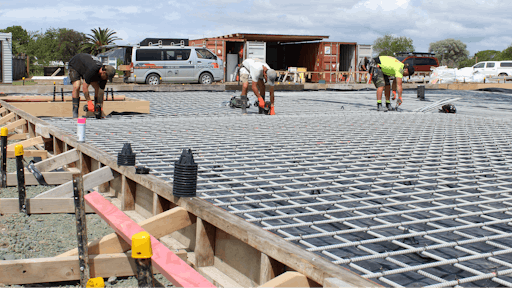Advanced Composites for Sturdy and Light-weight Building
Advanced Composites for Sturdy and Light-weight Building
Blog Article
Unlocking the Environmental Benefits of Recycled Compounds in Building And Construction and Style
In the realm of building and design, the utilization of recycled compounds holds considerable assurance for improving sustainability techniques and lowering ecological influence (composites). By incorporating these innovative products, there is a possible to resolve critical problems such as waste reduction, energy conservation, and a decrease in carbon impact. The change towards a more sustainable future in these markets depends upon opening the full possibility of recycled composites. This discussion will certainly discover the complex advantages and difficulties connected with incorporating recycled compounds into building and layout, providing a look into the transformative opportunities that lie in advance.

Ecological Influence Decrease
The decrease of environmental impact via the use of recycled compounds in building and style plays a critical role in lasting techniques. By incorporating recycled composites into structure products, the building and construction industry can considerably decrease its carbon footprint and add to a much more environmentally friendly future. These sustainable products, made from repurposed plastics, timber fibers, or various other recycled elements, use a practical choice to typical construction products without endangering on top quality or toughness.
Recycled compounds aid draw away waste from landfills and reduce the need for removing basic materials, hence saving natural deposits. In addition, the production procedure of these compounds typically eats much less power and emits fewer greenhouse gases compared to generating virgin materials (composites). This change in the direction of utilizing recycled composites not only decreases ecological harm but additionally promotes a round economic climate by encouraging the reuse of materials that would certainly or else be discarded
Waste Minimization
With a concentrate on minimizing waste in building and layout, the combination of recycled composites offers a lasting service to reduce environmental impact. Waste reduction is an essential aspect of sustainable practices, and using recycled composites presents an opportunity to achieve this objective successfully. By using materials that have currently offered their first objective, such as recycled plastics or reclaimed timber fibers, the construction and design markets can significantly decrease the quantity of waste produced and sent out to landfills.
Recycled composites have the possible to divert significant quantities of waste from conventional disposal approaches, adding to a much more round economic situation where resources are utilized successfully. In addition, the manufacturing process of recycled composites typically consumes much less energy and produces fewer exhausts compared to virgin products, further decreasing the environmental footprint of building and design jobs.
Implementing waste minimization techniques via the unification of recycled compounds not just assists in preserving natural deposits yet likewise advertises a more sustainable technique to building and designing for a greener future.
Energy Preservation
Incorporating recycled compounds not only decreases waste in building and construction and design yet additionally plays an essential role in enhancing power conservation techniques within the market. The usage of recycled composites in construction can considerably add to power conservation with different ways. By promoting the use of recycled composites in building and construction and design, the industry can make substantial strides towards accomplishing energy effectiveness and minimizing its carbon footprint, inevitably contributing to an extra sustainable constructed environment.
Carbon Footprint Decrease
Enhancing sustainability methods through the utilization of recycled compounds in building and construction and layout significantly minimizes the carbon footprint of the industry. By including recycled products right into the manufacturing of compounds, the requirement for virgin resources lowers, resulting in lower energy intake and greenhouse gas discharges connected with standard production procedures. This reduction in carbon footprint is vital in combating environment modification and advertising a more environmentally pleasant approach to building and construction and style.
In addition, the use of recycled composites also aids learn the facts here now in diverting waste from garbage dumps, consequently alleviating the environmental impact of disposal and promoting a round economic climate. The carbon footprint reduction accomplished through the fostering of recycled composites aligns with the global push in the direction of lasting techniques and the reduction of commercial emissions. It showcases a commitment to liable resource administration and a change towards greener alternatives in the construction and style sectors. Inevitably, by prioritizing the integration of recycled compounds, the market can make considerable strides in reducing its carbon impact and adding to a more lasting future.
Lasting Future
The assimilation of recycled compounds in construction and style not just addresses instant environmental worries however likewise lays a strong structure for a sustainable future in the industry. By incorporating recycled composites into structure products and products, the building and construction and layout markets can considerably reduce their dependence on virgin resources, causing a much more circular economic climate. This shift towards sustainability is critical for mitigating the ecological influence of standard construction practices, which commonly cause high degrees of waste generation and resource depletion.

Verdict
To conclude, recycled compounds supply substantial ecological benefits in construction and design by minimizing ecological effect, decreasing waste, preserving energy, reducing carbon impact, and promoting a sustainable future. Embracing making use of recycled composites can contribute to a more environmentally-friendly approach to structure and style, inevitably resulting in a more lasting and greener future for all.
The decrease of environmental influence via the use of recycled compounds in building and construction and design plays an important function in lasting methods.With an emphasis on lessening waste in building and construction and layout, the integration of recycled compounds offers a sustainable remedy to reduce ecological impact. By promoting the use of recycled compounds in building and construction and design, the industry can make substantial strides in the direction of achieving energy performance and lowering its carbon footprint, inevitably adding to an extra sustainable built atmosphere.

Report this page